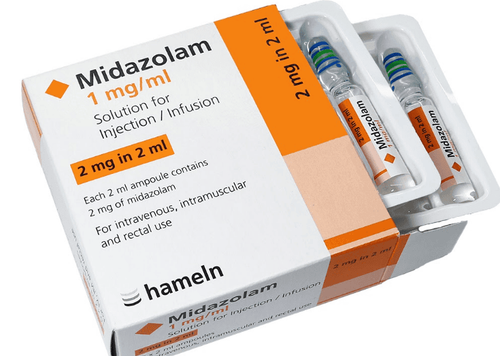This is an automatically translated article.
The article was professionally consulted with Specialist Doctor II Dinh Van Loc - Department of General Surgery - Vinmec Danang International General Hospital.Midazolam is a pharmaceutical commonly used in anesthesia, anesthesia or to treat insomnia, stress... The drug works by increasing the action of a natural chemical in the brain called GABA.
1. What are the uses of Midazolam?
Midazolam belongs to the group of benzodiazepines with sedative effects in the brain and central nervous system, so it is often used in combination with anesthesia, pre-anesthesia (to reduce anxiety and fear) and induce sleep in combination with other anesthetics. other anesthesia during laparoscopic surgery or short procedures.In addition, Midazolam is also a psychotropic drug with a sedative effect causing rapid, strong and short sleep, accompanied by short-term memory loss, or used to treat convulsions by giving drugs orally or by injection. intramuscularly, intravenously.
Adults
Conscious sedation before and during or during treatment with or without local anesthesia During anesthesia: + Pre-anesthesia before induction of anesthesia + Induction of anesthesia + As a component of safety psychiatry in combined anesthesia. Sedation in the intensive care unit In children
Sedation before and during diagnosis or during treatment with or without local anesthesia During anesthesia: + Pre-anesthesia prior to induction Sedation during intensive care room

2. Contraindications of the drug Midazolam
It should be noted when using the drug Midazolam has some of the following contraindications:Where there is no means of respiratory resuscitation, circulation, Hypersensitivity, severe acute respiratory failure, shock due to decreased circulating volume. Severe heart failure, myasthenia gravis, Breastfeeding women, Newborns, People with shock, coma or acute alcohol intoxication Also need to be cautious when using Midazolam in the following cases:
Elderly, debilitated: need dose reduction Patients with heart failure, heart disease are prone to severe drop in blood pressure, respiratory failure

Adults over 60 years of age Patients with chronic or debilitated diseases: + Chronic respiratory failure
+ Chronic renal failure, liver failure or heart failure
+ Pediatric heart disease
3. Dosage and how to use Midazolam in anesthesia
Depending on the purpose when used in anesthesia, Midazolam has different ways of use and dosage:Use in combination in anesthesia: intravenous injection for adults 30-100 micrograms/kg, repeat as needed or intravenous drip pulse 30-100 micrograms/kg/hour. Do not use for children and must reduce the dose in the elderly Use of pre-anesthesia: deep intramuscular injection for adults 70-100 micrograms/kg, children 1-15 years old: 80-200 micrograms/kg, children over 6 months old anus 300-500 micrograms/kg 15-30 minutes before induction of anesthesia Use for induction of anesthesia: adults 150-200 micrograms/kg by slow intravenous injection along with pre-anesthesia, if there is no pre-anesthesia, use a dose of 300-350 micrograms/kg. kg. The dose is increased in increments, spaced 2 minutes apart by no more than 5 mg. Maximum: 600 micrograms/kg and not for children.

Please dial HOTLINE for more information or register for an appointment HERE. Download MyVinmec app to make appointments faster and to manage your bookings easily.














